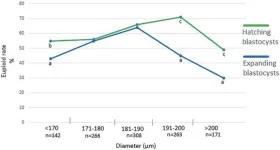(Press-News.org) Overcoming Delivery Challenges in Gene Editing
Modern genome editing techniques, including CRISPR systems, hold great potential for treating genetic diseases. However, delivering these molecular tools reliably to their target cells remains a significant challenge.
“Previous viral and non-viral delivery systems such as adeno-associated viruses (AAVs), lipid nanoparticles (LNPs), and other virus-like particles (VLPs), have been valuable but face limitations,” says Dr. Dong-Jiunn Jeffery Truong, last author of the study and group leader at the Institute for Synthetic Biomedicine at Helmholtz Munich. “Challenges include the increased persistence of gene editors potentially causing immune reactions, or simply their limited efficiency. ENVLPE directly addresses these issues while its modular design maintains compatibility with future gene-editing advancements.”
ENVLPE is based on modified, non-infectious virus-derived shells. These act as carriers for molecular gene editors such as base or prime editors – specialized CRISPR tools that can chemically change single DNA bases in the genome and remove or insert new DNA sequences. ENVLPE's design solves the logistics challenge of previous methods during the production of the VLPs by hijacking the intracellular transport mechanism so that all components come together at the right time and place.
Prior methods often included partially assembled, non-functional gene editors, reducing delivery effectiveness. “ENVLPE now not only ensures the packaging of fully assembled gene editors but also contains an extra molecular shield that protects the most vulnerable part of the editor from degradation during transport,” explains Truong. “This allows the genetic tools to be safely delivered into target cells where the intended DNA edit can take place.”
Restoring Vision: Gene Editing in Action
In close collaboration with a team led by Prof. Krzysztof Palczewski, a professor of ophthalmology at UC Irvine, the scientists tested the ENVLPE system in a mouse model of inherited blindness. “The mice carry a disabling mutation in the Rpe65 gene, which is essential for producing light-sensitive molecules in the retina, and therefore are fully blind and unresponsive to light,” explains Samuel W. Du, a co-author and MD/PhD candidate at UC Irvine. After injecting ENVLPE into the subretinal space (the area between the retinal pigment epithelium and photoreceptors) to correct the mutation, the animals began to respond to light stimuli again. “The extent of restoration was astounding,” says Julian Geilenkeuser, co-first author of the study and a doctoral researcher at the Institute for Synthetic Biomedicine. “It showed us that our particles have real therapeutic potential in a living animal.”
Compared to established systems, ENVLPE achieved significantly better results: a competing system required more than 10 times the dose to reach similar effects. “Our goal was to build a tool that is both useful for researchers and suitable for real-world applications,” says Niklas Armbrust, also co-first author and a doctoral researcher at the Institute for Synthetic Biomedicine. “We resolved critical bottlenecks and achieved a much more efficient packaging by the delivery agents.”
Advancing Cancer Therapy with Universal T Cells
ENVLPE could also open up new possibilities for adoptive T cell therapies, where immune cells taken from the patient are genetically modified in the lab so that they can specifically recognize and attack tumor cells. In collaboration with Dr. Andrea Schmidts’ laboratory at TUM University Hospital, ENVLPE facilitated the targeted removal of specific surface molecules that could trigger an immune response when the cells are administered to a recipient different from the donor. This could lead to the development of so-called “universal” T cells that do not need to be customized for individual patients, making treatments more accessible and cost-effective.
These innovations address critical challenges in both in vivo gene therapies for genetically inherited diseases and ex vivo cell therapies for cancer, paving the way for important translational advancements. “The highly modular ENVLPE system brings us substantially closer to on-demand and precise genetic modifications of complex cellular models,” says Prof. Gil Westmeyer, Director of the Institute for Synthetic Biomedicine and Professor for Neurobiological Engineering at TUM and co-senior author of the study. “It is an example of how synthetic biology can help drive medical innovation.”
Moving Toward Clinical Use
Having now achieved highly efficient delivery of the most common gene-editing tools, the team now seeks to use the diversity found in nature, along with the recent advancements in AI-assisted protein design, to increase targeting precision by restricting the delivery of these tools to specific cell or tissue types only. To move ENVLPE toward clinical application, the research team is pursuing follow-up funding from translational grants and partnerships in the pharmaceutical industry. The goal is to optimize the technology for various therapeutic applications and ultimately make it available to patients.
Info Box: What is ENVLPE?
ENVLPE stands for “Engineered Nucleocytosolic Vehicles for Loading of Programmable Editors.” These are non-infectious virus-like particles that can efficiently transport gene-editing tools such as base or prime editors into target cells. ENVLPE overcomes two major limitations of earlier systems: the instability of the guide RNA payload and inefficient packaging of only functional gene editors within the production cells. By adjusting intracellular transport mechanisms, the researchers significantly increased the system’s efficiency and safety.
About the Researchers
Dr. Dong-Jiunn Jeffery Truong, group leader at the Institute for Synthetic Biomedicine at Helmholtz Munich
Prof. Gil Westmeyer, Director of the Institute for Synthetic Biomedicine at Helmholtz Munich and Professor for Neurobiological Engineering at TUM
About Helmholtz Munich
Helmholtz Munich is a leading biomedical research center. Its mission is to develop breakthrough solutions for better health in a rapidly changing world. Interdisciplinary research teams focus on environmentally triggered diseases, especially the therapy and prevention of diabetes, obesity, allergies, and chronic lung diseases. With the power of artificial intelligence and bioengineering, researchers accelerate the translation to patients. Helmholtz Munich has around 2,500 employees and is headquartered in Munich/Neuherberg. It is a member of the Helmholtz Association, with more than 43,000 employees and 18 research centers the largest scientific organization in Germany. More about Helmholtz Munich (Helmholtz Zentrum München Deutsches Forschungszentrum für Gesundheit und Umwelt GmbH): www.helmholtz-munich.de/en
END
Engineering smart delivery for gene editors
2025-04-09
ELSE PRESS RELEASES FROM THIS DATE:
Six ape genomes sequenced telomere-to-telomere
2025-04-09
Comprehensive reference genomes have now been assembled for six ape species: siamang (a Southeast Asian gibbon), Sumatran orangutan, Bornean orangutan, gorilla, bonobo and chimpanzee. Areas of their genomes previously inaccessible because of structural complexity have now mostly been resolved.
The resource is already lending itself to comparative studies that offer new insights into human and ape evolution, and into what underlies the functional differences among these species.
A report on how the telomere-to-telomere ape genome references were developed, and what scientists are learning from it, appears in the April 9 edition ...
Hubble Space telescope unveils the first images of ongoing star cluster mergers near the center of dwarf galaxies
2025-04-09
A new study reports the first direct observation of merging star clusters in the nuclear region of dwarf galaxies. This detection confirms the feasibility of this formation route for nuclei in dwarf galaxies, which has long been debated. The study was published in Nature science journal, and led by Postdoctoral Researcher Mélina Poulain from the University of Oulu, Finland.
Dwarf galaxies are the most abundant type of galaxies that populate the Universe. Composed of 100 times fewer stars than the ...
‘Sugar’ signatures help identify and classify pancreatic cancer cell subtypes
2025-04-09
GRAND RAPIDS, Mich. (April 9, 2025) — Van Andel Institute scientists and collaborators have developed a new method for identifying and classifying pancreatic cancer cell subtypes based on sugars found on the outside of cancer cells.
These sugars, called glycans, help cells recognize and communicate with each other. They also act as a cellular “signature,” with each subtype of pancreatic cancer cell possessing a different composition of glycans.
The new method, multiplexed glycan immunofluorescence, combines ...
Every cloud has a silver lining: DeepSeek’s light through acute respiratory distress syndrome shadows
2025-04-09
Acute respiratory distress syndrome (ARDS) continues to be a tough nut to crack in critical care, taking lives despite years of research and better ventilator strategies. It is defined by acute hypoxemia, bilateral infiltrates on chest imaging, and non-cardiogenic pulmonary edema, and it remains a heterogeneous condition with mortality rates stubbornly close to 40%. Its complexity—spanning diverse etiologies, inflammatory profiles, and therapeutic responses—demands innovative solutions beyond traditional paradigms. In recent years, artificial intelligence ...
Scientific Program announced for inaugural eLTER Science Conference in Finland
2025-04-09
The scientific programme for the inaugural eLTER Science Conference has just been launched, marking a major milestone in the lead-up to the event. Held from 23 to 27 June 2025 in Tampere, Finland, the conference will explore integrated, policy-relevant approaches to ecosystem and socio-ecological research under the theme: “Toward a whole-system approach to ecosystem science.”
Organised by the Integrated European Long-Term Ecosystem, critical zone and socio-ecological systems Research Infrastructure (eLTER RI), the event is expected to welcome over 300 participants from across Europe and beyond.
The scientific programme features:
25 keynote speakers recognised for their leadership ...
Does blastocyst size matter? Exploring reproductive aging and genetic testing
2025-04-09
“[…] when selecting non-PGT-A tested embryos for embryo transfer (ET) or frozen embryo transfer (FET), a small hatching blastocyst seems to be a better choice than a large expanded one, especially for advanced-age patients for whom the risk of aneuploidy is higher.”
BUFFALO, NY — April 9, 2025 — A new research paper was published in Aging (Aging-US) Volume 17, Issue 3, on March 5, 2025, titled “Reproductive aging, preimplantation genetic testing for aneuploidy, and the diameter of blastocysts: does size matter?”
In this study, a team led by first author Jakub Wyroba from the Malopolski Institute of Fertility Diagnostics ...
2025 EurekAlert! Travel Awards for International Science Reporters applications now open
2025-04-09
Applications for the 2025 EurekAlert! Travel Awards for International Science Reporters are now open to early-career science journalists from Brazil and countries in Eastern Europe. Two winners will be selected to receive travel funding from EurekAlert! to attend the 2026 AAAS Annual Meeting, taking place February 12-14, 2026 in Phoenix, Arizona, USA. Learn more about who is eligible and how to apply on our website. The application deadline is May 5 at 11:59 p.m. U.S. Eastern Time.
Learn More and Apply!
The American Association for the Advancement of Science (AAAS) is the world’s largest multidisciplinary scientific society, and the AAAS Annual Meeting brings together ...
Menstrual cycle may contribute to sickle cell disease pain crises
2025-04-09
(WASHINGTON— April 9, 2025) — A marker linked to inflammation, C-reactive protein, may increase significantly during the follicular phase of the menstrual cycle in female patients with sickle cell disease (SCD), according to emerging research published today in Blood Vessels, Thrombosis & Hemostasis. This observation provides insight into the pattern of painful vaso-occlusive events (VOEs), which are driven by inflammation, in female patients with the disorder.
“We know both from the literature and anecdotally from our patients that women with SCD have VOEs that cluster ...
PolyU scholar unveils research on long-term effects of obesity on brain and cognitive health
2025-04-09
With the global prevalence of obesity on the rise, it is crucial to explore the neural mechanisms linked to obesity and its influence on brain and cognitive health. However, the impact of obesity on the brain is complex and multilevel. To address this, Prof. Anqi QIU, Professor of the Department of Health Technology and Informatics at the Hong Kong Polytechnic University (PolyU) and Global STEM Scholar, has unveiled novel research to advance our understanding of the neural mechanisms underlying the relationship between obesity and its implications for cognitive health in adults.
Obesity ...
Comprehensive Keck Medicine of USC medical office building coming soon to Pasadena
2025-04-09
LOS ANGELES — Keck Medicine of USC will open a four-story, 100,000 square-foot, state-of-the-art medical office building located at 590 S. Fair Oaks Ave. in Pasadena in fall 2025.
As the newest addition to the renowned academic health system, the location will significantly expand Keck Medicine clinical care for residents of Pasadena and neighboring communities in the San Gabriel Valley.
What sets the new Pasadena location apart
“This new location — our largest and most advanced outpatient setting — will ...





